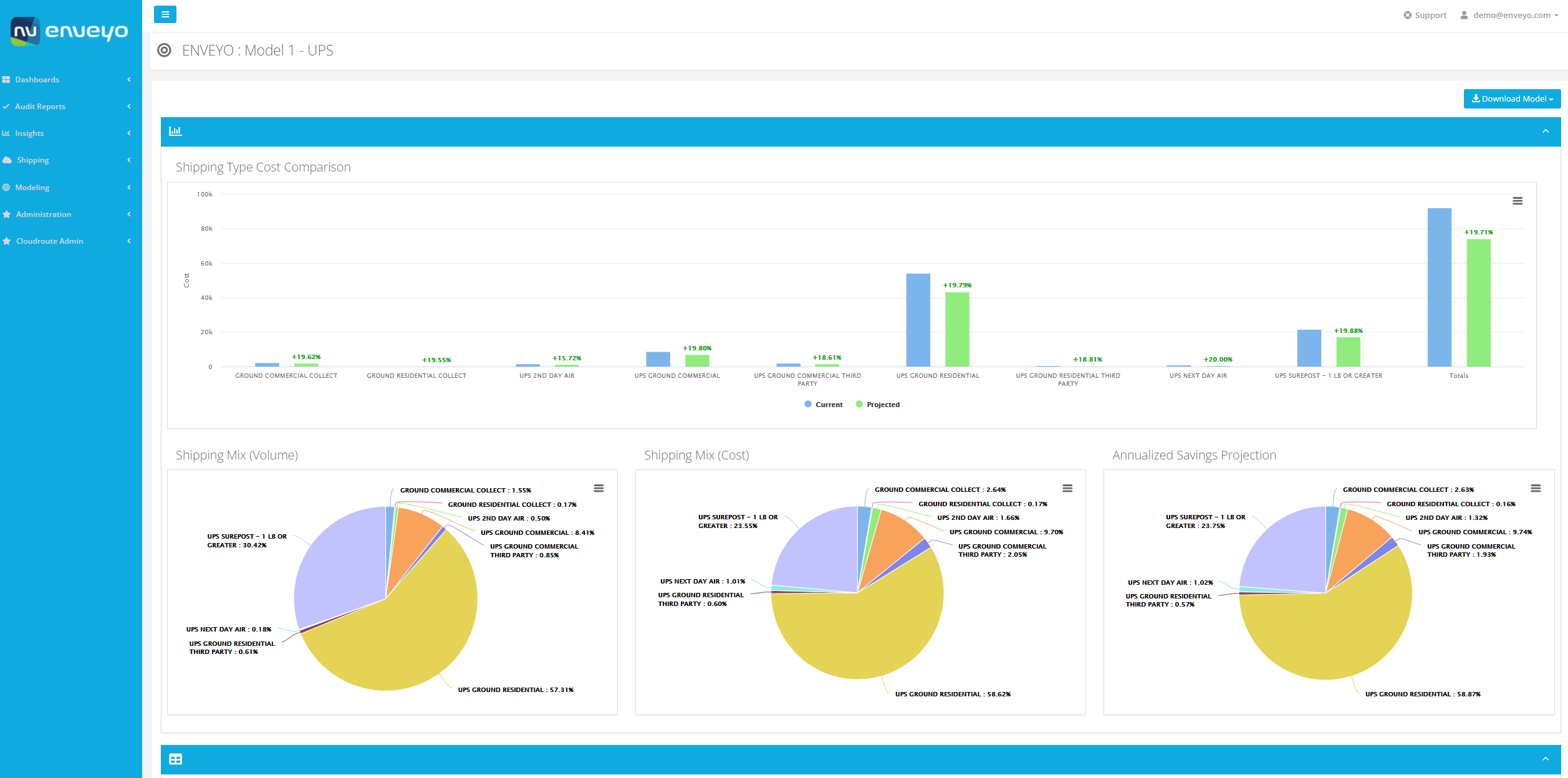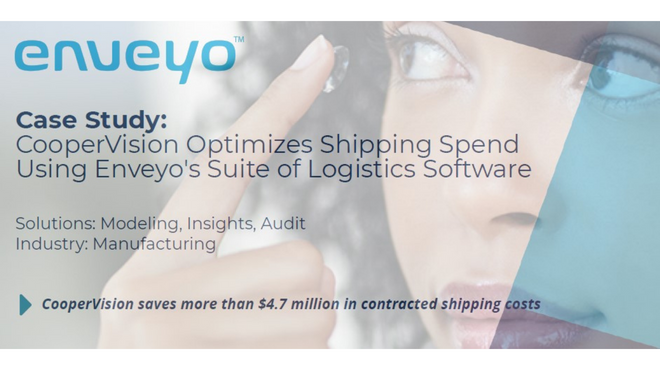Have you ever “bet the farm” on a single decision? Most of us aren’t that impulsive, however every day, people bet big – black or red, hit or stand, play or fold. Sometimes it works out as they’d hoped, but most of the time, the house takes it all and they go home wishing they had a second chance.
In supply chain & logistics, big decisions have equivalent consequences. So the next time you’re tasked with making a business-critical decision, will you blindly “bet your company or career” on the decision you make knowing you may not get a second chance?
Thankfully, in supply chain & logistics we have technology to aid in our decision-making processes, and don’t need to rely on just trusting our gut instincts.
Organizations that want a clear look into the future need to leverage predictive modeling software to identify potential outcomes of their decisions before they make them, because even small, seemingly insignificant changes to your shipping operation can have substantial implications down the road. These implications are very difficult, if not impossible, to see using traditional reporting tools. So, when it comes to making business-critical shipping decisions… are you willing to bet your career on your it?
Let’s explore why predictive modeling software gives supply chain professionals a high level of confidence in making big shipping decisions.
What is Predictive Modeling Software?
Predictive modeling software reduces the risk in making shifts to your shipping program through in-depth scenario analysis. From small tweaks in your distribution center to global supply chain initiatives, predictive modeling supports teams in making faster, smarter, more accurate decisions by relying on the data to tell the story.
Shippers gain a high level of confidence in their decision making because predictive modeling scenario outcomes are on average within 1-2% accuracy of the actual outcome. This is made possible by robust data management software that analyzes every possible variable in your shipping program affecting your decision-making process.
Here are the top 5 questions leading shippers are leveraging Enveyo’s predictive modeling software for when making their big decisions.
Predictive Modeling Software: The Top 5 Questions Answered
1. As carrier rates and surcharges increase, how is that going to affect me?
Carrier rate increases continue to generate a lot of buzz, especially leading up to and during peak season. In October 2022, charges from FedEx for additional handling and oversized packages will nearly double as consumers begin to place orders for the holidays. UPS’ new fuel tables went into effect in September, increasing fuel rates above already inflated costs. Among these two major carriers, the announced average rate increase across all services in 2022 is 5.9% – but typically the real net increase is much higher when actually applied to each shippers’ unique shipping profile
Strategies to mitigate the impact of these rate increases will vary based on your shipping volume and the primary services you leverage across carriers; however, the starting point is modeling your current carrier contract against newly announced or proposed rates to uncover the real total cost impact. By leveraging an intelligent TMS, you can then redirect shipping volume across carriers as necessary to reduce costs wherever possible, yet ensure a smooth and positive customer delivery experience.
2. We’re comparing proposals across major carriers… how should we approach negotiations?
Are you team UPS or FedEx?
Trick question.
When it comes to major carriers, wearing only a purple or brown jersey can be a big no-no in today’s dynamic parcel shipping environment. Each major carrier has pros and cons, but understanding the nuances of their services and surcharges, as well as how each of them perform in your highest volume segments, is key to minimizing shipping costs and optimizing your customers’ delivery experience.
Major carriers deal with averages when preparing a new proposal for your shipping program. To ensure you negotiate on the terms that matter, use predictive modeling software that compares contracts (between carriers or a new contract with your current carrier) and re-rates each shipment as if your new rates are in place, not with averages. Because no two shippers are the same, accepting broad-level assumptions and rate averages will all but guarantee you’re paying more than you should until you’re back at the negotiating table armed with the data that matters. A predictive modeling output will accurately show your expected spend with each contract’s terms so you can make the most valuable move.
Leveraging predictive modeling software further supports your carrier contract negotiations by analyzing anonymized market data. Based on your actual shipping volume and spend, you’re able to benchmark your performance against other leading shippers, resulting in strategic carrier contract negotiations and making the smartest decisions for your organization.
3. Can we distribute volume to regional and final mile carriers and keep our discount with our major carrier?
“You don’t get fired for working with FedEx or UPS.” If we had a nickel for every time we heard that… Well, we’d have a lot of nickels.
Parcel shipping volume exploded in 2020 and 99% of all packages were delivered by 4 carriers. And during that time, the carriers you don’t get fired for partnering with capped many shippers’ volumes, putting their customers (shippers) in an even tougher spot.
Regional and final mile carriers both emerged and expanded their coverage over the past two years to support both shippers’ and end consumers’ needs, yet many shippers are still apprehensive to shift package volume out of fear they’ll lose their volume-based discounts. Using predictive modeling software will help you understand what a diversified carrier strategy could look like and identify the right regional and final mile carriers you can shift volume to, while hitting your primary carrier revenue band and keeping the discount you worked hard to establish. For example, a predictive modeling output can show you how one carrier will perform for you versus another within your highest volume shipping zones.

4. We want to get our products closer to our customers. Do we add a distribution center? Or partner with a 3PL?
Decentralized distribution is a key strategy for many shippers looking to get products closer to their customers and decrease time in transit, shipping costs, and their carbon footprint. Performing a center of gravity study with predictive modeling software will help you find the answers to fuel your strategic decision-making process.
Many variables go into deciding between adding a new DC or partnering with one (or multiple) 3PLs, and leveraging predictive modeling software ensures that you’re looking at every relevant variable at the closest level of detail, including:
- Shipping volume by carrier and service
- Time in transit by carrier and zone
- Geographical purchase volume and associated shipping costs
- Comparative 3PL discounts by service
And if you’re a 3PL, predictive modeling software also supports your efforts in identifying what products to stock in each of your warehouses to ensure that each of your unique clients’ end consumers have a top-notch experience with your fulfillment practices.
5. We’re a 3PL considering onboarding a new client… will they be profitable for us, and can we add value for them?
Many 3PLs have experienced growth since the start of the pandemic, which is largely driven by shippers’ demand to get products closer to their customers and lower destination shipping zones. Not every prospective customer knocking on a 3PL’s door however will be a profitable customer. By leveraging predictive modeling software, 3PLs can quickly identify if a prospective customer will not only be profitable for their business, but also if they can provide cost savings and added value for the e-commerce brand.
For example, predictive modeling software can be used to perform a 3PL sales model. A 3PL sales model compares the prospective customer’s actual shipping data against the 3PL’s negotiated rate structure to identify areas of cost savings for the client and profit margin for the 3PL. The 3PL sales model output can then be used in partnership conversations to further enable the sales team and illustrate the 3PL’s value to the client.
On the flip side, a 3PL sales model output may also show that an e-commerce prospect is not a good fit for the 3PL to onboard for fulfillment services due to high operating costs and low margin. Regardless of the output, predictive modeling software is invaluable to 3PLs looking to identify the most valuable prospects for long-term success.
Learn more about Enveyo’s solutions for 3PLs.
Conclusion
In today’s shipping landscape, you need to be resilient and agile. The speed in which the market is shifting means you need to be prepared to shift with it, but more importantly, make proactive shifts instead of reactive. Using predictive modeling software as part of your supply chain and logistics strategy empowers your team with insightful tools that drive proactive and accurate decision making.
Predictive modeling software gives your organization clear visibility about the consequences of potential choices and enables you to choose the outcome with the best possible trade-off between your different goals.
The answers to each of these top 5 questions resides in the data.. Your shipping data is your most powerful weapon in supply chain and logistics optimization. Enveyo’s predictive modeling software helps you wield it. Schedule a meeting to see how.






